Episode 260: Great Dinosaur Rush is Major Fun

|
Release Date: April 24, 2017 |
Download: PDF |
||
|
Designer: Scott Almes |
Publisher: APE Games |
||
|
2-5 pl 60 min ages 10+ MSRP $50 |
|
Tweet |
|
There’s little doubt today’s world is dino-crazy. Few things fire our imagination like seeing the bones of these massive reptilian beasts. And yet this was not always the case. Dinosaurs became part of popular culture due to the Great Dinosaur Rush over 120 years ago!
In the late 1800s, rival paleontologists scrambled to be the first to discover and promote new species of dinosaurs. They often stooped to devious and underhanded means to compete with and embarrass anyone who happened to get in the way. This race for bones led to the discoveries of over 142 species of dinosaurs. And this flood of new bones to museums sparked public interest and the dino-craze that still rages on today.
In The Great Dinosaur Rush, each player is a famous fossil hunter searching the American prairie for bones. You will use these bones to physically build your own dinosaur each turn, either real or imagined, hoping to score big in the museum exhibit.
But beware, your opponents may try to sabotage your efforts along the way. You may need to play a little dirty to win, but if you gain too much notoriety, it will cost your dearly!
Read on to explore our in-depth review of the game and learn why we think it is worth of the Major Fun AND Spiel of Approval Awards!
Written review continues after the break.
The Great Dinosaur Rush APE Games | BGG | Amazon

The Concept
There’s little doubt today’s world is dino-crazy. Few things fire our imagination like seeing the bones of these massive reptilian beasts that once ruled the Earth. And yet this was not always the case. Dinosaurs became part of popular culture due to the Great Dinosaur Rush over 120 years ago!
In the late 1800s, rival paleontologists scrambled to be the first to discover and promote new species of dinosaurs. They often stooped to devious and underhanded means to compete with and embarrass anyone who happened to get in the way. This Wild West approach to science left a black mark on American paleontology but this race for bones led to the discoveries of over 142 species of dinosaurs in a just a few year’s time! The flood of new bones to museums sparked public interest and the dino-craze that still rages on today!
In The Great Dinosaur Rush, each player is a famous fossil hunter from this era in history. Over three rounds you will search the American prairie for bones and use them to build the best dinosaurs and place them in museums. But beware, your opponents may try to sabotage your efforts along the way! You may need to play a little dirty to win, but if you gain too much notoriety, you could lose everything!
The Components
The game comes with a bag of 210 wooden dinosaur bones. The bones come in five different colors, each color representing a different part of a dinosaur’s skeleton. Some will go on the board and the rest go in a drawstring bag.

There’s a game board representing the dig sites where you will discover the bones and several museum score tracks.

Each player has a screen (which you will use when building your dinos) plus a wooden paleontologist meeple and some scoring cubes.

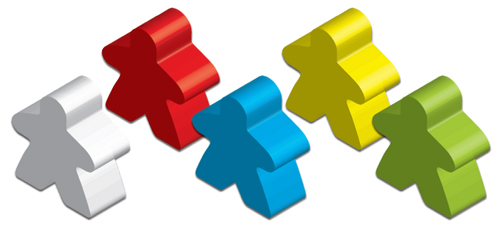
There’s a bag of 45 notoriety tokens. The tokens are numbered 1-3. When you do underhanded things, you’ll have to draw from this bag.
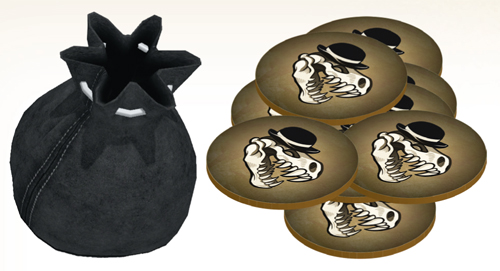
There are 15 paleontologist cards, each one representing an actual fossil hunter of the era, complete with a small bio.

Last but not least are the 21 Dinosaur Bonus Cards. These cards show a specific layout of bones to create named dinosaurs. Some you may know and love and many you may not.

The Mechanics
The game is played over the course of three turns. Each turn you has three parts: field, build and exhibit.
The field phase has the most parts and is the real meat of the game.
In the field phase, players collect bones, move their paleontologist on the board, adjust the museum score track and then take an action. Some of these actions are normal and some are notorious. If you take a notorious action, you will have to draw from the dreaded notoreity bag which can hurt your chances at winning.
Let’s look at each part in a little more detail.
You collect bones based on where your paleontologist is on the board. On the first turn, each space has three bones. Empty spaces will fill in with two on turn two and one on the last turn of the game, meaning you’ll collect the most bones early in the game and the least bones later on.

You move your paleontologist in a straight line as far as you want. You can pass other players but not tar pits. Remember, wherever you land, you’ll be picking up bones there to start your next turn.
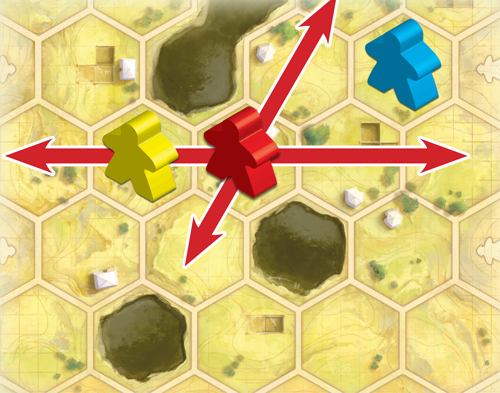
On the board there are five museum scoring tracks. Each one corresponds to a different aspect of the dinosaur you’re going to build: size, height, length, ferocity, uniqueness. You choose one track and move its score cube up or down. This is your chance to improve or diminish the scoring potential for one particular aspect.

So after collecting, moving and adjusting the museum track you have one final choice to make: what action do you want to take?
There are three normal and three notorious actions from which to choose.
Normal actions go like this.
Publicize: You can move a score cube on one museum track up or down again.
Donate: You can get rid of three bones to score points or get rid of a notoriety token.
Research: You can draw an extra dinosaur bonus card.
Notorious actions go like this.
Sabotage: You can draw and place a notoriety token on the board. Anyone who moves through this space will have to pick it up.
Dynamite: You get rid of the three bones on the space where you stand and then draw three new bones from the bag and keep them.
Steal: You can steal a bone from a space adjacent to the one where you stand, including a space with an opponent.
Notorious actions come with a catch, though. You must draw a notoriety token from the bag. The tokens are numbered 1-3. Keep your tokens secret. They will either help you or really hurt you when it comes time to score at the end of the game. Playing a little dirty is ok, as long as the other players are dirtier than you!
It might seem like a lot to take in the first turn but each part flows nicely to the next. There’s a nice aid with the actions on your player screen so you can see all your options at a glance.
Even better, there’s a family version of the game included that ignores notoreity altogether, so you can ease yourself into the game if the many actions seem too much at first.
Players will repeat the field phase three times each turn and then move on to Build and Exhibit, which brings us to….
What Sets This Game Apart
All the decisions you take in the field phase, to acquire bones, to move and position the museum track - all the actions you take are driven by one goal: build the best dinosaur you can!
Now this isnt some theoretical task. You actually get to take the bones you collect and physically build a dinosaur behind your screen!!
Remember the colored bones correspond to particular parts, so each dino must have a head, a neck, a spine, ribs, two limbs and might even have some unique features. There’s a helpful chart on each player screen outlining the various requirements for building your dino.
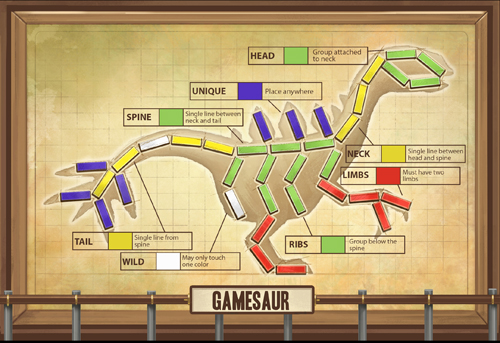
The important thing to remember is that within these general guidelines, the sky’s the limit. You can arrange the bones to make your own personal dinosaur any way you can imagine. Dinosaurs like these!
Behold the Dogosaurus. Notice the spiked tail and horns. A reptilian cousin to man’s best friend?
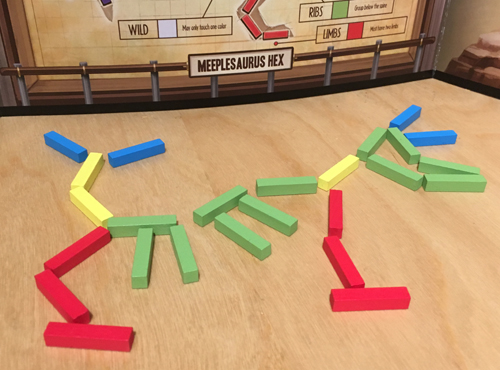
Next up is the Squareadactyl. Graceful wings lifted this gentle square headed beast into the clouds.

The mighty Trianasaurus Rex hopped like a kangaroo on its massive hind legs and attacked with the massive triangular cudgel on its tail.
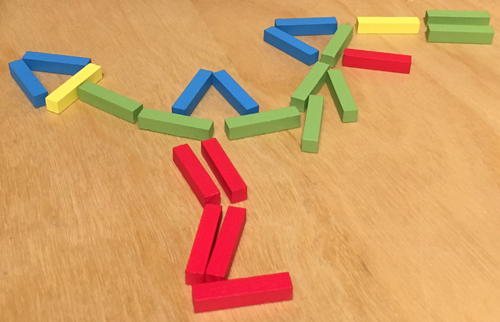
And last but not least is the Overbitetrodon. Its massive head and bottome jawis held up by an ultra-strong neck. It feeds itself using arms on its head and twin tails.

And if you’ve done a great job collecting the right bones, you may even be able to build one of the dinos depicted on your bonus cards. These will score extra points.
I cannot adequately express how fun it is to be in charge of creating your own dinosaur each turn. You must use all the bones you collect so you may have to get creative with extra long tails or a giant head or a really really long set of arms. It’s a bit like a puzzle but it’s a puzzle that you can form and reform until you find the shape that pleases you best and (you hope!) will score you the most points. Best yet, you keep the bones you dug up on previous turns, so as the game moves forward, you’ll build bigger and bigger dinosaurs.
And honestly, regardless of your ultimate scoring potential, so much of the joy of the game comes from putting your dino together in a way that will cause the others to laugh and marvel when they see your creation!
When everyone is ready, you reveal your dinos and move on to the Exhibit, the last phase of each turn. Look back to the museum tracks and score based on the position of the cubes on each track.
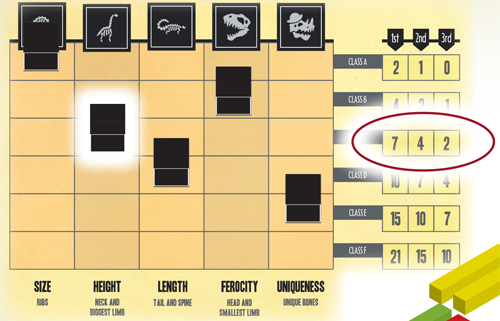
Who has the largest dino? (the most ribs)
Who has the tallest dino? (neck plus the longest limb)
Who has the longest dino? (tail plus spine)
Who has the most ferocious dino? (head plus shortest limb)
Who has the most rare dino (most unique bones).
First second and third places score, so even if you’re not the longest or tallest, you can still rack up points. If you’re able to build any of your special dino cards, show them and score those points too.
So there’s planning during the field phase, the joy and strategy of making dinos in the build phase, and then the payoff with scoring points in the exhibit phase. Each turn ends with its own payoff which makes each turn almost feel like a game in and of itself.
At game’s end the high score wins the game BUT…
Remember those Notoriety tokens? The player with the most notoriety has to SUBTRACT his or her total notoriety taken throughout the game from his or her final score. Other players get to ADD their notoriety to their scores! This means if you play too nicely, you may miss out on a bunch of points and if you play too dirty, you run the risk of a huge negative at the end of the game. The trick is to be a little mean but not so mean you cost yourself the game. It’s a terriffic challenge - very cleverly implemented but easy to understand.
Final Thoughts
The Great Dinosaur Rush is certainly at the higher end of the complexity scale when it comes to Major Fun but it is a worth recipient of both honors due to the inclusion of the family rules and the outrageous amount of fun and freedom players have in creating new dinosaurs every turn.
As a Spiel of Approval winner, the game provides great payoff for strategic thinking and the notoriety mechanics give each decision several layers to think through. There’s also a great deal of effort to bring the actual history of the period into the game. Each paleontologist not only has a short biography but they each have a special power that is in synch with the person’s story as well.
For instance, you can play as Mary Anning a noted fossil hunter who discovered one of the first and most complete pterodactyls. She was the inspiration for the tongue twister "She sells seashells down by the seashore. " Since she was such a prolific fossil hunter, her ability allows her to draw three bones from the bag and place them in her space on the board if that space is empty.

Or you could play as Barnum "Mr. Bones" Brown. He was the cheif fossil hunter for the American Museum of Natural History. His preferred method of searching for fossils was dynamiting fields and picking through the rubble. Naturally, his ability involves dynamite. If you take the dynamtie action, you get to draw an extra bone from the bag.

I love games that can be appreciated by many different players on many different levels. The Great Dinosaur Rush is a wonderful example of a game that strikes a fantastic and fun balance between strategy and accessibility.
Plus, did I mention you get to build dinosaurs every turn?
Easy to see why this game has won our hearts. Give it a go and I think there’s a good chance it might stomp and roar its way into your heart, too.
***
